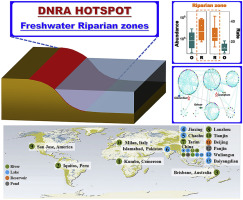当前位置:
X-MOL 学术
›
Water Res.
›
论文详情
Our official English website, www.x-mol.net, welcomes your
feedback! (Note: you will need to create a separate account there.)
Hotspot of dissimilatory nitrate reduction to ammonium (DNRA) process in freshwater sediments of riparian zones.
Water Research ( IF 11.4 ) Pub Date : 2020-01-30 , DOI: 10.1016/j.watres.2020.115539 Shanyun Wang 1 , Yanxia Pi 1 , Yiping Song 1 , Yingying Jiang 1 , Liguang Zhou 1 , Weiyue Liu 1 , Guibing Zhu 1
Water Research ( IF 11.4 ) Pub Date : 2020-01-30 , DOI: 10.1016/j.watres.2020.115539 Shanyun Wang 1 , Yanxia Pi 1 , Yiping Song 1 , Yingying Jiang 1 , Liguang Zhou 1 , Weiyue Liu 1 , Guibing Zhu 1
Affiliation

|
Dissimilatory nitrate reduction to ammonium (DNRA), an important intermediate process in the N-cycle, links N-compound oxidation and reduction processes. Hence, the oxic-anoxic interface would be the hotspot of the DNRA process. In freshwater ecosystems, the riparian zone is the most typical carrier of the oxic-anoxic interface. Here we report spatio-temporal evidence of a higher abundance and rate of DNRA in the riparian zone than in the open water sediments based on molecular and 15N isotopic-tracing technologies, hence signifying a hotspot for the DNRA process. These abudance and rates were significantly higher than those in open water sediments. 15N isotopic paring technology revealed that the DNRA hotspot promoted higher rates of N-compound oxidation (NO2-), reduction (NO3- and DNRA), and N2 production (anammox and denitrification) in the riparian zone than those in open water sediment. However, high-through sequencing analysis showed that the DNRA bacteria in the riparian zone and openwater sediments were insignificantly different. Network and correlation analysis showed that the DNRA abundance and rates were significantly positively correlated with TOM, TC/NH4+, and TC/NO2-, but not with the dominant genera (Anaeromyxobacter, Lacunisphaera, and Sorangium), which played different roles on the connection in the respective community networks. The DNRA process in the riparian zone could be driven mainly by the related environmental biogeochemical characteristics induced by anthropogenic changes, followed by microbial processes. This result provides valuable information for the management of riparian zones because anthropogenic changes in the riparian water table are expected to increase, inducing consequent changes in the reduction from NO3- to NH4+.
中文翻译:

河岸带淡水沉积物中异化硝酸盐还原成铵(DNRA)过程的热点。
硝酸盐异化还原为铵盐(DNRA)是N循环中的重要中间过程,将N化合物的氧化和还原过程联系在一起。因此,含氧-缺氧界面将是DNRA过程的热点。在淡水生态系统中,河岸带是有氧-缺氧界面的最典型载体。在这里,我们报告了时空证据,表明基于分子和15N同位素示踪技术的河岸带中DNRA的丰度和发生率高于开放水域沉积物中的DNRA,因此标志着DNRA过程的热点。这些外观和比率显着高于开放水沉积物中的比率。15N同位素削皮技术表明DNRA热点促进了N化合物氧化(NO2-),还原(NO3-和DNRA)的较高速率,河岸带的N 2产生(厌氧氨化和反硝化)要比开放水沉积物中的N 2产生(厌氧和反硝化)高。但是,高通量测序分析表明,河岸带和开放水域沉积物中的DNRA细菌差异不明显。网络和相关性分析表明,DNRA的丰度和发生率与TOM,TC / NH4 +和TC / NO2-呈显着正相关,但与显性属(厌氧杆菌,乳酸杆菌和Sorangium)却没有显着正相关,而显性属在连接中起着不同的作用。在各自的社区网络中。河岸带的DNRA过程可能主要由人为变化引起的相关环境生物地球化学特征驱动,随后是微生物过程。
更新日期:2020-01-31
中文翻译:

河岸带淡水沉积物中异化硝酸盐还原成铵(DNRA)过程的热点。
硝酸盐异化还原为铵盐(DNRA)是N循环中的重要中间过程,将N化合物的氧化和还原过程联系在一起。因此,含氧-缺氧界面将是DNRA过程的热点。在淡水生态系统中,河岸带是有氧-缺氧界面的最典型载体。在这里,我们报告了时空证据,表明基于分子和15N同位素示踪技术的河岸带中DNRA的丰度和发生率高于开放水域沉积物中的DNRA,因此标志着DNRA过程的热点。这些外观和比率显着高于开放水沉积物中的比率。15N同位素削皮技术表明DNRA热点促进了N化合物氧化(NO2-),还原(NO3-和DNRA)的较高速率,河岸带的N 2产生(厌氧氨化和反硝化)要比开放水沉积物中的N 2产生(厌氧和反硝化)高。但是,高通量测序分析表明,河岸带和开放水域沉积物中的DNRA细菌差异不明显。网络和相关性分析表明,DNRA的丰度和发生率与TOM,TC / NH4 +和TC / NO2-呈显着正相关,但与显性属(厌氧杆菌,乳酸杆菌和Sorangium)却没有显着正相关,而显性属在连接中起着不同的作用。在各自的社区网络中。河岸带的DNRA过程可能主要由人为变化引起的相关环境生物地球化学特征驱动,随后是微生物过程。











































 京公网安备 11010802027423号
京公网安备 11010802027423号